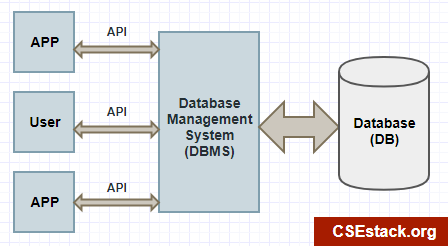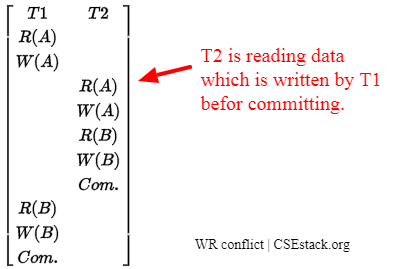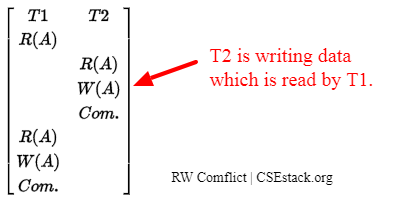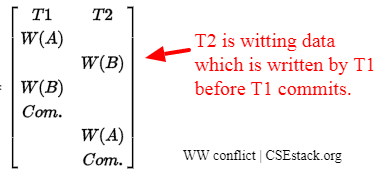Which Of The Following Is A Means Of Nullifying Conflicts Among Data Types?
What is Read-Write conflict in the database? Why does it occur in the DBMS (Database Management System)?
Data is crucial for any kind of project. Text information required for the project can be saved in a file or in any reliable database. Days are gone when we were using text files system to salve the data.
In a database management organization (DBMS), data is saved in the database. There are many advantages of using a DBMS organization over the file system.
In this article, we volition see all the different types of read write disharmonize in DBMS.
Table of Contents
- How does Data Conflict Occur?
- Different Types of Read-Write Conflict in Database
- Write-Read (WR) disharmonize
- Read-Write (RW) disharmonize
- Write-Write (WW) conflict
How does Data Conflict Occur in DBMS?
Data is saved into the database. And to fetch and write data from the database, yous need to perform read and write operation on the data.
There are multiple entities (multiple users, multiple APPs, multiple websites…) performing these multiple operations on the same data at the same time.

Just as an instance, in that location is a centralized cyberbanking database where all the data nearly the users and the banking company related information is saved.
In that location might be multiple user logins to their bank account and admission the same banking company information at the same time. They perform diverse operations similar reading or updating or deleting the data.
So basically there are two types of operations that can exist performed on the database.
1. Read functioning:
Read the data value from the database. It is a safe operation, as it does not update any information in the database.
2. Write functioning:
It writes data into the database and saved it for further apply. After writing data, data has to be committed (Commit Functioning) to making updated information available for further operations. This operation is more decumbent to vulnerability as it involves modifying database information.
For a data update functioning, it involves both the reading and writing operation.
What is Transaction in Database?
The fix of these multiple operations/instruction (to accomplish a detail task) are performed on the data. This set is called as Transaction.
Every entity accessing data holds dissimilar transaction and all the transactions execute simultaneously.
The operations involved in the successful Transaction:
- Read the data
- Alter read data values
- Write the data back
- Commit the transaction
While performing these operations past the unlike users on the same data at the same time may ascend data conflict. As similar, accessing data by one transaction before committing another transaction does non hold good and gives information conflict.
There are different types of information conflict happens during reading and writing operations chosen as "Read-Write conflict".
Dissimilar Types of Read Write Conflict in DBMS:
As I mentioned it earlier, the read performance is safe as it does modify any information. And so, there is no Read-Read (RR) disharmonize in the database.
Whatever number of transactions are free to read the aforementioned data (without conflict) anytime as long as at that place is no write operation.
So, at that place are three types of disharmonize in the database transaction.
- Write-Read (WR) conflict
- Read-Write (RW) conflict
- Write-Write (WW) conflict
Let's see i-by-one with the case.
What is Write-Read (WR) conflict?
This disharmonize occurs when a transaction read the data which is written by the other transaction earlier committing.
In the following diagram, I am using the following notions
A, B - two different data objects from database T1, T2 - two unlike transactions R(A) - reading data A W(A) - Writing information A Com. - committing transaction

Here, the transaction T2 is reading the data which is written by the T1 before T2 commits. It is likewise chosen as Dirty Read.
Information technology violates the ACID property of data consistency dominion.
Expected behavior:
The new transaction (says T2) should non read the value if whatever other some other transaction (say T1) already has written the data and has not committed.
What is Read-Write (RW) conflict?

Transaction T2 is Writing information which is previously read by transaction T1.
Hither if you lot wait at the diagram above, data read by transaction T1 before and later on T2 commits is different.
Instance:
Suppose Alice and Bob want to book the flight for their vacation. Alice open up airlines website to check the availability and cost of the ticket. There is simply one ticket is available. Alice finds it expensive and looks for other airlines fares if she gets any offers.
Meanwhile, Bob logins to the aforementioned airline portal and volume the ticket. Now, there is no more flight ticket available.
Alice does not find any good offer on other airlines portal, she comes back to the previous airline portal. And tried to book a flight ticket even it is not available. Its Conflict, Read-Write (WR) conflict.
What is Write-Write (WW) disharmonize?

Hither Transaction T2 is writing data which is already written past other transaction T1. T2 overwrites the information written by T1. It is too called as a blind write operation.
Data written past T1 has vanished. So it is data update loss.
Case:
Alice and Bob share mutual Google-canvass online. Both read the file. Alice updates the certificate and forgets to salve the file. On another terminate, Bob updates the Google sheet and salve the file.
The content updated by Alice is overwritten by Bob. The information updated by Alice is lost. It is called as Write-Write (WW) conflict.
This is all nigh unlike types of read write conflict in DBMS. If you have whatsoever dubiety or whatever thought about this commodity, write a annotate below. I will reply y'all dorsum as soon as possible.
Which Of The Following Is A Means Of Nullifying Conflicts Among Data Types?,
Source: https://www.csestack.org/different-types-read-write-conflict-database/
Posted by: martintrathem2001.blogspot.com


0 Response to "Which Of The Following Is A Means Of Nullifying Conflicts Among Data Types?"
Post a Comment